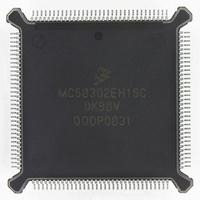MC68302EH16C Freescale Semiconductor, MC68302EH16C Datasheet - Page 160

MC68302EH16C
Manufacturer Part Number
MC68302EH16C
Description
IC MPU MULTI-PROTOCOL 132-PQFP
Manufacturer
Freescale Semiconductor
Datasheets
1.MC68302AG20C.pdf
(4 pages)
2.MC68302AG20C.pdf
(2 pages)
3.MC68302AG20C.pdf
(13 pages)
4.MC68302EH16C.pdf
(481 pages)
Specifications of MC68302EH16C
Processor Type
M683xx 32-Bit
Speed
16MHz
Voltage
5V
Mounting Type
Surface Mount
Package / Case
132-MQFP, 132-PQFP
Controller Family/series
68K
Core Size
32 Bit
Ram Memory Size
1152Byte
Cpu Speed
16MHz
No. Of Timers
3
Embedded Interface Type
SCP, TDM
Digital Ic Case Style
PQFP
Rohs Compliant
Yes
Family Name
M68000
Device Core
ColdFire
Device Core Size
32b
Frequency (max)
16MHz
Instruction Set Architecture
RISC
Supply Voltage 1 (typ)
5V
Operating Temp Range
0C to 70C
Operating Temperature Classification
Commercial
Mounting
Surface Mount
Pin Count
132
Package Type
PQFP
Lead Free Status / RoHS Status
Lead free / RoHS Compliant
Features
-
Lead Free Status / Rohs Status
RoHS Compliant part
Electrostatic Device
Available stocks
Company
Part Number
Manufacturer
Quantity
Price
Company:
Part Number:
MC68302EH16C
Manufacturer:
Freescale Semiconductor
Quantity:
135
Company:
Part Number:
MC68302EH16C
Manufacturer:
PANA
Quantity:
99
Company:
Part Number:
MC68302EH16C
Manufacturer:
Freescale Semiconductor
Quantity:
10 000
Part Number:
MC68302EH16C
Manufacturer:
FREESCALE
Quantity:
20 000
Company:
Part Number:
MC68302EH16CB1
Manufacturer:
Freescale Semiconductor
Quantity:
10 000
Company:
Part Number:
MC68302EH16CR2
Manufacturer:
Freescale Semiconductor
Quantity:
10 000
- MC68302AG20C PDF datasheet
- MC68302AG20C PDF datasheet #2
- MC68302AG20C PDF datasheet #3
- MC68302EH16C PDF datasheet #4
- Current page: 160 of 481
- Download datasheet (2Mb)
Communications Processor (CP)
Bits 7–3—Reserved for future use.
ID—Idle Status on the Receiver Line
CD—Carrier Detect Status on the Channel Pin
CTS —Clear-to-Send Status on the Channel Pin.
When the CTS and CD lines are programmed to software control in the SCC mode register,
these lines do not affect the SCC and can be used for other purposes such as a data set
ready (DSR), a data terminal ready (DTR) line, or an interrupt source in the SCCE register
according to the behavior just described.
4.5.8.4 Bus Error on SDMA Access
4-40
This bit is meaningful only if the SCC is programmed to HDLC or UART mode. In HDLC
mode, this bit is a one after 15 continuous ones are received on the line. This bit will be
zero after a single zero occurs on the line. If flags, rather than idles, are received between
frames, the ID bit will remain zero between frames.
In UART mode, this bit is a one after one idle character (9 to 13 bits) is received and is a
zero after a single zero occurs on the line (e.g., a start bit).
If the DIAG1–DIAG0 bits in the SCM are programmed to normal mode, then the CD signal
is an enable signal for ID status. In this case, if CD is not asserted, the ID bit will always
be one, regardless of the activity on the line.
If the DIAG1–DIAG0 bits in the SCM are programmed to software operation mode, then
the ID bit will always reflect line activity, regardless of the state of the CD pin.
The ID bit is valid in both the multiplexed and nonmultiplexed modes, once the ENR bit is
set.
This bit has the same polarity as the external pin. In the multiplexed modes, it is always
zero. CD is undefined until ENR is set.
This bit has the same polarity as the external pin. In the PCM highway mode, it is always
zero. In the GCI and IDL mode, if the SCC is connected to the D channel, then this bit is
valid; otherwise, it is always zero. CTS is undefined until the ENT bit is set.
When a bus error occurs on an access by the SDMA channel, the CP generates a unique
interrupt (see 3.2 Interrupt Controller). The interrupt service routine should read the bus
error channel number from the parameter RAM at BASE + 67C as follows:
0—SCC1 Tx Channel
1—SCC1 Rx Channel or DRAM Refresh Cycle
2—SCC2 Tx Channel
3—SCC2 Rx Channel
gardless of what happens externally. This signifies that the cor-
responding SCCS bit is now valid.
7
RESERVED
MC68302 USER’S MANUAL
3
ID
2
CD
1
CTS
0
MOTOROLA
Related parts for MC68302EH16C
Image
Part Number
Description
Manufacturer
Datasheet
Request
R
Part Number:
Description:
Manufacturer:
Freescale Semiconductor, Inc
Datasheet:

Part Number:
Description:
MC68302 Configuring the Chip Selects on the MC68302
Manufacturer:
Motorola / Freescale Semiconductor

Part Number:
Description:
MC68302 Design Concept - Expanding Interrupts on the MC68302
Manufacturer:
Motorola / Freescale Semiconductor

Part Number:
Description:
MC68302 MC68302 Adapting a WAN Controller to a LAN Environment
Manufacturer:
Motorola / Freescale Semiconductor

Part Number:
Description:
MC68302 EKB Applications - Power Measurements on the MC68302
Manufacturer:
Motorola / Freescale Semiconductor

Part Number:
Description:
MC68302 Interfacing the MC68020 to a Slave MC68302
Manufacturer:
Motorola / Freescale Semiconductor

Part Number:
Description:
MC68302 MC68302 Software Performance
Manufacturer:
Motorola / Freescale Semiconductor

Part Number:
Description:
MC68302 Evaluating EDX on the ADS302
Manufacturer:
Motorola / Freescale Semiconductor

Part Number:
Description:
MC68302 Design Advisory #1 - MC68SC302 Passive ISDN Protocol Engine
Manufacturer:
Motorola / Freescale Semiconductor

Part Number:
Description:
MC68302, MC68360, and MPC860 Characteristics and Design Notes for Crystal Feedback Oscillators
Manufacturer:
Motorola / Freescale Semiconductor
Part Number:
Description:
Mc68302 Integrated Multi-protocol Processor
Manufacturer:
Freescale Semiconductor, Inc
Datasheet:
Part Number:
Description:
Manufacturer:
Freescale Semiconductor, Inc
Datasheet:
Part Number:
Description:
Manufacturer:
Freescale Semiconductor, Inc
Datasheet:
Part Number:
Description:
Manufacturer:
Freescale Semiconductor, Inc
Datasheet:
Part Number:
Description:
Manufacturer:
Freescale Semiconductor, Inc
Datasheet:











